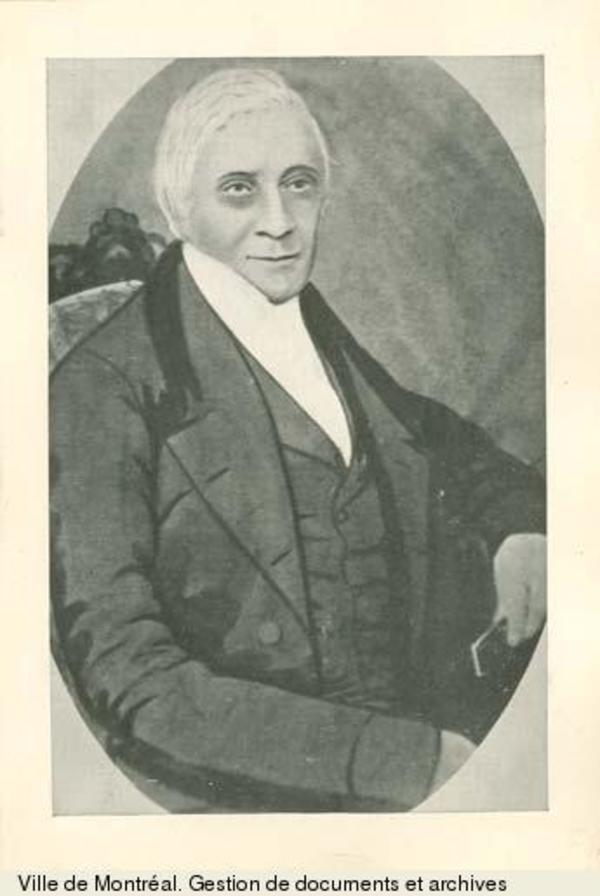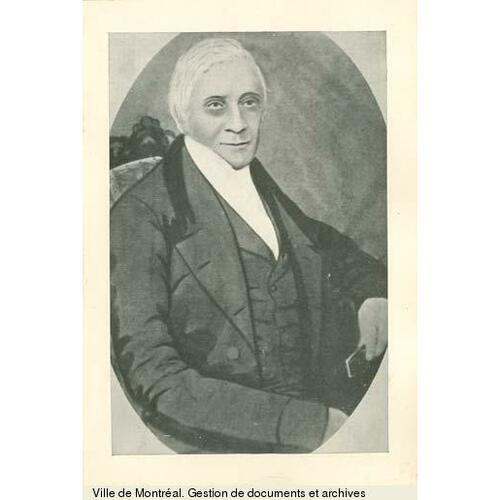
Source: Link
GALE, SAMUEL, surveyor, land claims agent, office holder, and notary; b. 14 Oct. 1747 in Kimpton, Hampshire, England; d. 27 June 1826 in Farnham, Lower Canada.
Samuel Gale came to America about 1770, apparently as a paymaster in the British army. Well educated and trained as a surveyor, in 1772 he was appointed to the lucrative office of deputy surveyor general of New York. The same year he issued a prospectus of a work in preparation entitled “The complete surveyor,” but it does not appear to have been published. On 25 June 1773 he married Rebecca, eldest daughter of Samuel Wells of Brattleboro (Vt). Gale began to survey disputed land grants in New Hampshire for New York speculators; they no doubt included William Smith*, prominent attorney and politician, for whom Wells was land agent. In March 1774 Gale was appointed clerk of the Inferior Court of Common Pleas for Cumberland County (Windham County, Vt), on which his father-in-law sat as a judge.
Gale was well positioned to profit from land speculation on the New York–New Hampshire border, but progress towards making his fortune ended abruptly in 1775. It was claimed that on 13 March he had played an inflammatory role in a pre-revolutionary scuffle in Westminster (Vt) during which two men taking part in an occupation of the Cumberland County court-house were killed. Gale was confined for three weeks by local whigs. After moving with his family to Long Island, N.Y., he was apprehended by the rebel military the following spring and jailed without charge in Connecticut for more than two months. Released by order of the New York Provincial Congress, he became cashier for the deputy paymaster general of the British army. In 1780 he switched to the position of itinerant paymaster in Virginia, the Carolinas, and Florida, and gave full satisfaction in the post.
After the war Gale pressed claim in London to a pension for loss of his professional income, but his case was weakened by his not having served in a military capacity; as well, his property, although confiscated, had not been sold, and he was thus prevented from proving its irrevocable loss. Gale attempted to strengthen his claim to an annuity by publishing An essay on the nature and principles of public credit (1784), a complicated treatise on means of gradually extinguishing Britain’s public debt; it was followed by two additional volumes in 1785 and another in 1787. In 1785 he received a small temporary annuity of £40, apparently raised about 1788 to £100.
In 1791 Gale accepted an invitation to Quebec by William Smith, who had become chief justice of Lower Canada, and upon his arrival he became principal assistant to Surveyor General Samuel Johannes Holland*. His organization of the province’s chaotic land records made possible the publication in 1795 of a map – the outline of which had been drawn under his supervision by Jean-Baptiste Duberger – displaying the grants issued during and after the French régime and the boundaries of surveyed townships. However, that year Lord Dorchester [Guy Carleton*] failed to support a recommendation by the Executive Council for a small raise in Gale’s meagre stipend of 5s. a day, and Gale resigned in bitterness. Smith’s successor, William Osgoode, asserted that Gale had been “the most able Surveyor and perhaps the most diligent Officer that ever was employed in Service of Government.”
Gale threw himself into the task of defending the claims of those who had received warrants of survey after the townships were officially opened for settlement in 1792. Under Smith’s chairmanship of the Executive Council’s land committee, some 173 warrants were issued, largely to Americans, for the survey of townships. Smith argued that rapid settlement by Americans was the surest means of repairing the “rent” in the empire, and he persuaded the committee to accept a local version of the American system of leaders and associates for the granting of lands. As the system operated in Lower Canada, a group of petitioners would be granted up to an entire township, each associate compensating the group leader for the expenses of, among other things, surveying lots and building roads and mills, generally by turning over 1,000 acres of a maximum grant of 1,200 acres. The leaders were thus expected to become progenitors of a landed aristocracy. Many councillors objected to Smith’s activities in land-granting as favouring his friends, such as Gale and the Wellses, and promoting union with the United States. Gale attempted to speed up the granting process by drafting “Chamber Surveys” rather than waiting for boundaries to be verified in the field, but bureaucratic delays and Smith’s death in 1793 gradually brought it to a halt for the original petitioners.
In 1794 the land committee, under Hugh Finlay*, opened the township lands, even those already under warrant for survey, to new applications for grants. It argued that the original recipients of warrants were mere speculators and that, their warrants having expired, government was free to grant the townships to new petitioners; the latter were mainly Quebec officials and their merchant allies. Gale hinted at “some secret motive” on the part of councillors, and in fact Finlay was later revealed to have conspired to take over townships which American claimants had begun to develop. Gale’s warning that civil unrest in border townships might follow the reopening of lands to new petitioners was answered by Finlay to the effect that American settlers, “with their pernicious principles,” should not be allowed to settle in the province. The council itself introduced obstacles that frustrated even the most loyal and diligent of the original claimants. However, in the spring of 1796 Gale became private secretary to Dorchester’s successor, Robert Prescott*, and he soon won the new head of the colony to his clients’ side; two years later, on Prescott’s recommendation, Home Secretary the Duke of Portland dispatched new regulations authorizing grants to the original claimants based on their investment and progress in promoting settlement. Officials at Quebec protested, and a public conflict developed between the Executive Council and Prescott. The governor’s bitterest critic was Osgoode, whose estimation of Gale took a decided turn for the worse; the “Man of the Woods” was identified as “a Land Jobber” and “a disappointed Land Speculator” busily engaged in stirring up “the Liberty Boys of Vermont.”
When Prescott was recalled in 1799 Gale accompanied him to England, where he remained for almost three years, lobbying on behalf of the original claimants to ten townships, among whom were Gilbert Hyatt and John Savage. On 5 Feb. 1800 he presented a lengthy petition documenting their progress in colonization. Finding it ignored, in the fall he had a shortened form printed for each privy councillor; it pointed out that of the hundreds of loyalists who had received orders in council for land prior to 1791, only ten or twelve had obtained title, and reiterated suspicions of the personal motives of the executive councillors in rejecting those petitioners of 1792 who had made substantial investments in good faith. In the spring of 1802 Gale’s petition was finally rejected, although the Privy Council did agree that titles should be issued to settlers with location certificates dated prior to 1791. If Gale’s mission had largely failed, his presence in London may well have stimulated the Executive Council to adopt a more generous policy towards his clients. Gale had probably had to cover most of his living expenses, but he had been promised a commission of five per cent on whatever his clients were granted, which presumably he collected.
Through Prescott, Gale, seven brothers-in-law, and two nephews had received in 1798 a total of 9,600 acres in Farnham Township. Although that township had been set aside for individual loyalist claimants, the Gale–Wells family grant had followed the pattern of the system of leaders and associates, the main difference being that the associates did not sign over the bulk of their allotments to Gale. Several in-laws, including Micah Townsend, Vermont’s first secretary of state, eventually joined Gale at Farnham. There, on his estate in comfortable obscurity, Gale played the country squire, accumulating a fine library, and, it appears, acquiring the sobriquet of “Judge” although he was only a notary, commissioned in March 1800; he conducted a small practice from 1802 to 1819. Aside from championing settlers in the townships, who, being mostly Americans, resisted at the beginning of the War of 1812 enforcement of militia laws that would oblige them to fight relatives and former friends, Gale does not appear to have been active in public life. His son, Samuel*, became a judge and a wealthy landowner. Gale’s death in 1826 followed by just six months that of his wife.
Samuel Gale is the author of An essay on the nature and principles of public credit (4v., London, 1784–87). In connection with his mission to London from 1799 to 1802 Gale published The memorial and petition of the undersigned attorney for . . . applicants for grant of various tracts . . . of waste lands . . . in Lower Canada (London, [1800]) and Reply to the report of the Executive Council of the province of Lower Canada, upon the memorial of the undersigned attorney, to the lords of his majesty’s most honourable Privy Council, of the 28th of November 1800 . . . (London, 1802). William Berczy* did a portrait of the Gale family which included Samuel, and probably did one of Gale alone because Gale is said to have brought a copy to London in 1799. It is not known whether these portraits are extant. Gale’s minute-book is held at ANQ-E, CN2-21.
Brome County Hist. Soc. Arch., (Knowlton, Que.), Samuel Gale papers; Samuel Willard papers (mfm. at PAC). McCord Museum, Samuel Gale papers, IV, 68. New York Public Library,
Cite This Article
J. I. Little, “GALE, SAMUEL (1747-1826),” in Dictionary of Canadian Biography, vol. 6, University of Toronto/Université Laval, 2003–, accessed January 18, 2026, https://www.biographi.ca/en/bio/gale_samuel_1747_1826_6E.html.
The citation above shows the format for footnotes and endnotes according to the Chicago manual of style (16th edition). Information to be used in other citation formats:
| Permalink: | https://www.biographi.ca/en/bio/gale_samuel_1747_1826_6E.html |
| Author of Article: | J. I. Little |
| Title of Article: | GALE, SAMUEL (1747-1826) |
| Publication Name: | Dictionary of Canadian Biography, vol. 6 |
| Publisher: | University of Toronto/Université Laval |
| Year of publication: | 1987 |
| Year of revision: | 1987 |
| Access Date: | January 18, 2026 |



